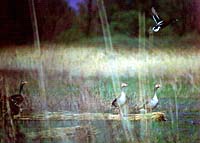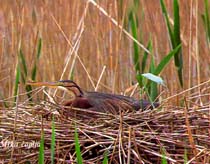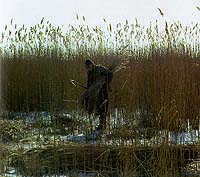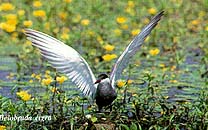|
Fossil remains of mammoth, ursus and rhinoceros
tell us about the wildlife near "Ludasko Jezero" at the end of the
glacial age, while the first traces of human settlements date back
to 16,000 years BC. Written documents reveal that the prehistoric
settlement of Ludas, Ludasegyhaz or Ludaspuszta has existed. Since
the word "ludas" in Hungarian means "goose", the above names
of the settlement are probably in some relation to the former
nesting of the wild goose at the area of Ludasko Jezero. The old
maps, however, show that once there was just a large swampy
terrain, while the first contours of the lake were shown on a map
drawn at the end of the 17th century. At that time,
Ludasko Jezero and Palicko Jezero represented "the blue eyes of
the Pannonian Plain".
Ludasko Jezero is a shallow steppe lake
placed 12 km to the east of Subotica. It covers a 4 km-long
depression which is located between the dunes, on sand terrain and
loess terrace. In the environmental sense, Ludasko Jezero is
marked by a characteristic "high eastern bank" whose loess slopes
rise up to 5-6 m above the lake level, the feature no other
aeolian lake in our country has. The bottom of the lake is covered
by the impermeable layer of white clay mostly covered with
mud.

Because
of its natural values, but also because it has been endangered, in
1994 Ludasko Jezero obtained the status of first category Special Nature Reserve by
the decree of the Government of the Republic of Serbia, i.e. it
became the valuable natural asset and the landscape of national
importance. |
|
Protection measures on the international level
were first introduced in 1973 when the Executive Council of SAP of
Vojvodina took the initiative to nominate Ludasko Jezero to the Ramsar Site List. In 1976
the Government of the SFRY ratified the Ramsar Convention (Ramsar,
Iran, 1971), and on March 28, 1977 Ludasko Jezero was
included in the list of Wetlands of International Importance as a
site where rare birds breeds and nest, as well as the
ornithological resting site for a large number of migratory
species.
Because of its basic features, Ludasko Jezero and its
surroundings were in 1989 designated as IBA (Important Bird
Areas).
The "The
White-Headed Duck" Project, which was launched in Hungary
during the 1980s and at the beginning of the 1990s, called for the
effort to reintroduce the white-headed duck at Ludasko Jezero and
Palicko Jezero. This action has not been carried out because of
the new position of our country in the changed global
policy. |


| |
By the action of ringing the
birds from Ludasko Jezero, the Ecological Association "Richard Csornai"
of Subotica joined the International Research Project on Migration of
Reedbirds - ACROPROJECT.
|

|
Extremely diverse habitats of the Ludasko Jezero (aquatic,
swamp and meadow habitats, as well as steppe habitats on its
banks) brought about the rich diversity of plant and animal
species and their life communities. Former aquatic phytocoenoses
were, in changed conditions, i.e. high nutrient concentrations and
thick mud layers, succeeded by plankton communities, especially by
phytoplankton ones. Marsh vegetation is dominated by reeds, which
grow in mosaically distributed stands - "little reed islands" -
that are remembered as the specific characteristic of the lake.
Surrounding lowland terrain is covered by the wet and saline
meadows where the protected species of the cuckooflower (Orchis laxiflora subsp.
palustris) grows. |
| Relict steppe vegetation growing on loess and sand terrain
has gradually given way to arable land and is, thus, seen today
only in fragments on the high eastern bank. Several natural
rarities found their shelter here, such as: milk-vetch (Astragalus excapus),
wind-flower (Pulsatilla pratensis), sage (Salvia austriaca),
periwinkle (Vinca herbacea), groundsel (Senecio doria), etc.
These species are regarded as endangered, and are, as such,
included in the Red
List of Flora of Serbia. In spite of great
natural value of these steppe fragments, it should not be
forgotten that the basic and primary value of the Ludasko Jezero
Reserve is its lake ecosystem. |

|
Recent ecological conditions have influenced the
bottom fauna to become poor. Fish fauna includes 18 species from the
family, of carp, perch, pike, spined loach, and wels. The notable
characteristic of fish fauna is the absence of predator fish species. At
Ludasko Jezero 11 species of amphibians and reptiles have been recorded,
including the species of the common tree frog of genus Rana. Another specific
characteristic of the lake is an extremely dense population (if the
marsh turtle (Emys orbicularis),
which is endangered in whole Serbia.
Bird fauna is characterized by the presence of 214 recorded
species, 140 of them being protected as natural rarities. They represent
the fundamental characteristic of this valuable natural area which is
included in the list of especially valuable sites for Yugoslavia and
Europe. Ludasko Jezero is a habitat of many rare and endangered bird
species in Europe, such as: white-headed duck (Oxyura leucocephala),
Ferruginous duck (Aythya
nyroca), (Acrocephalus melanopogon) and (Panurus biarmicus), the
latter being the most outstanding characteristics of its avifauna. At
the same time, this lake is the place where many migratory bird species
from the large group of "waterfowl" gather.
Teriofauna is represented by nearly twenty aquatic and
terrestrial species. Prominent natural rarity of Ludasko Jezero is otter
(Lutra lutra), endangered
species in Serbia and in Europe.
Being the lake-marshy ecosystem in a steppe area, Ludasko Jezero
is characterized by rich and diverse wildlife, i.e. it has a great
ecological potential which was verified when it was designated as one of
the Ramsar sites and IBA areas. Preservation of diverse aquatic life
communities, and meadow, saline and steppe ecosystems on land, is
ecologically important since the above are nesting areas or resting
sites for migratory waterfowl.
Following
the concept of sustained development, i.e. wise use of the area's
biodiversity, nature protection management includes, apart from active
conservation, the development of ecological tourism and, in the buffer
zone, the production of healthy food. After ecological evaluation of
reeds is finished, the area covered with old reeds should be designated
for conservation and left unchanged for the benefit of the species which
are ecologically connected to these microhabitats. Local people should
be advised to leave the traditional reed cutting for wintertime (so
called "winter harvest"). In this way they will implement active
protection measures on this mosaic complex at Ludasko
Jezero.

Water bodies represent the key factor of survival of
native ecosystems at Ludasko Jezero. Water is accumulated by
precipitation, underground waters and the Keres river, which often dries
up. In the past, the Bega river also brought waters to this terrain.
Today its old riverbed represents an "output canal" for Palicko Jezero
whose waters, rich in nutrients (especially in nitrogen and phosphorus),
flow through the old riverbed into Ludasko Jezero. Since Palicko Jezero
receives the sewage waters from the town of Subotica, the condition of
the water biotop of Ludasko Jezero is inseparably related to Palicko
Jezero. In the vicinity of the lake, in the buffer zone, there is arable
land which physically and chemically endangers the rich flora and fauna
of Ludasko Jezero, which, as a result, is dying off even faster.
Eutrophication is also accelerated by the ill practice of draining water
from the lake for irrigation, through the powerful watering system of
the "Pescara" agricultural organization. This practice causes mud
movements from the northern part of the lake to the southern part.
Muddying of this section of the lake, where the water used to be "clean"
to the depth of 1.7 m, resulted in spreading of reed
islands.
In
the northern part of the lake, where the waters have always been shallow
(down to I m deep), mud and other adverse factors have resulted in the
development of vast reed complexes. The reeds, which had a great market
value in the past, are today of poor quality, and their populations are
declining. The Wild goose has not been nesting in such thick reeds since
1950s, probably because mowing of the surrounding wet meadows has
reduced its natural feeding area. Intensive hunting has destroyed the
white-headed duck. Because of the intensive water pollution, there are
neither water lily plant communities nor colonies of sooty tern. Great
changes in bulky saline marsh habitats during 1960s have reduced the
nesting of the large black-tailed godwit, while the disappearance of
Slano Jezero caused the European avocet to stop nesting in this
area.

In these changed ecological conditions, the reeds
spread over the steppe habitats located on the loess slopes of the
eastern bank of Ludasko Jezero, "suffocating" the populations of rare
species of the Red List of Serbia, and changing the structure of relict
xerothermic plant communities.
The first decree to
protect Ludasko Jezero was passed in 1955. In 1958 this area was
designated as the Strict Natural Reserve. In 1982 the area became an
integral part of the "Palic-Ludas" Regional Park, while one part of
Ludas kept the status of the Strict Natural Reserve, where more strict
protection regime was applied. Because of the construction of the E-75
highway in 1991, the "Palic-Ludas" Regional Park was divided into two
different areas - Palicko Jezero and Ludasko Jezero - with the same
protection status. Three years later (in 1994), Ludasko Jezero became
the Special Natural Reserve of great importance for the Republic of
Serbia.
Protection of this valuable natural area is currently being
implemented through the adopted protection measures. The strictest
protection is being applied on the zone of the first level of
protection, where there are preserved ecosystems and habitats of rare
flora and fauna. All activities, apart from those carried out for the
scientific and educational purposes, are strictly forbidden. The second
level of protection is being applied to the area comprising less
specific habitats. In the zones, where the third level of protection is
being applied, limited and
controlled exploitation of natural resources is permitted, along with
preservation of its traditional natural values.
We plan to undertake continual monitoring of the total
biodiversity of this
Reserve. Apart from that, the Institute for Protection of Nature of
Serbia shall monitor the state of this valuable natural area and its management, analyze the
factors that aggravate it and implement the accepted protection
programs. Our work shall
also be carried out through the traditional Intentional
Ornithological Eco-camp "Ludas", particularly by ringing of birds.
Action plan for Preservation and Development of Biodiversity issued by
the Republic of Serbia (1995-1999) envisaged the foundation of the
research station (experimental center). Its first job should be to
reintroduce white-headed duck (Oxyura leucocephala) and wild goose
(Anser anser).
|